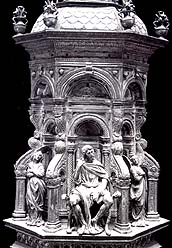 |
THE GREAT
TRADITION OF
FLORENTINE SILVERWARE |
| Italiano Grazie !  "Ariento" Consortium  List of Members  Tradition of Florentine Silverware  |
 |
 These
make it the most excellent collective identification in
the exaltation of every Florentine citizen's sense of
belonging, of communal defence, and the maintaining of
securities, in a system of superior values, that
guaranteed a ruling class and a relative social peace.
They are the most sacred silver works from the past still
in existence, in as much as a defence of the community of
believers and their joint interests. Also, because such
pieces have often been subject to scatterings due to
certain events, including the fortune of families,
changes in taste, warring, or catastrophic occurrences.
With the Republic fallen, Cosimo I de' Medici, the Grand
Duke, in 1537 tranferred the Florentine government to an
appointed court, destined to become the most These
make it the most excellent collective identification in
the exaltation of every Florentine citizen's sense of
belonging, of communal defence, and the maintaining of
securities, in a system of superior values, that
guaranteed a ruling class and a relative social peace.
They are the most sacred silver works from the past still
in existence, in as much as a defence of the community of
believers and their joint interests. Also, because such
pieces have often been subject to scatterings due to
certain events, including the fortune of families,
changes in taste, warring, or catastrophic occurrences.
With the Republic fallen, Cosimo I de' Medici, the Grand
Duke, in 1537 tranferred the Florentine government to an
appointed court, destined to become the most
|








